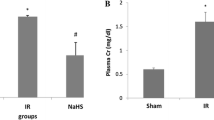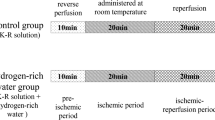Abstract
Purpose
Renal ischemia–reperfusion (I/R), an important cause of acute kidney injury, is unavoidable during various types of operations, including renal transplantation, surgical revascularization of the renal artery, partial nephrectomy, and treatment of suprarenal aortic aneurysms. Exacerbation of I/R injury is mediated by reactive oxygen species (ROS). A recent study has shown that hydrogen has antioxidant properties. In this study, we tested the hypothesis that a hydrogen-rich saline solution (HRSS) attenuates renal I/R injury in a rodent model.
Methods
Rats were treated with an intravenous injection of HRSS or control saline solution followed by renal I/R. After 24 h of treatment, we performed a histological examination and transmission electron microscopy, and measured serum levels of 8-OHdG.
Results
Histological analysis revealed a marked reduction of interstitial congestion, edema, inflammation, and hemorrhage in renal tissue harvested 24 h after HRSS treatment compared to saline administration. Renal I/R injury, which led to altered mitochondrial morphology, was also inhibited by HRSS. Furthermore, serum 8-OHdG levels were significantly lower in rats treated with HRSS and subjected to renal I/R.
Conclusions
These protective effects were likely due to the antioxidant properties of HRSS. These results suggest that HRSS is a potential therapeutic candidate for treating various I/R diseases.



Similar content being viewed by others
References
Sharples EJ, Thiemermann C, Yaqoob MM. Mechanisms of disease: cell death in acute renal failure and emerging evidence for a protective role of erythropoietin. Nat Clin Pract Nephrol. 2005;1:87–97.
Perico N, Cattaneo D, Sayegh MH, Remuzzi G. Delayed graft function in kidney transplantation. Lancet. 2004;364:1814–27.
Lu CY, Penfield JG, Kielar ML, Vazquez MA, Jeyarajah DR. Hypothesis: is renal allograft rejection initiated by the response to injury sustained during the transplant process? Kidney Int. 1999;55:2157–68.
Lameire N, Van Biesen W, Vanholder R. The changing epidemiology of acute renal failure. Nat Clin Pract Nephrol. 2006;2:364–77.
Noiri E, Nakao A, Uchida K, Tsukahara H, Ohno M, Fujita T, Brodsky S, Goligorsky MS. Oxidative and nitrosative stress in acute renal ischemia. Am J Physiol Renal Physiol. 2001;281:F948–57.
Devarajan P. Update on mechanisms of ischemic acute kidney injury. J Am Soc Nephrol. 2006;17:1503–20.
Rodrigo R, Bosco C. Oxidative stress and protective effects of polyphenols: comparative studies in human and rodent kidney. A review. Comp Biochem Physiol C Toxicol Pharmacol. 2006;142:317–27.
Bonventre JV, Weinberg JM. Recent advances in the pathophysiology of ischemic acute renal failure. J Am Soc Nephrol. 2003;14:2199–210.
Montagna G, Hofer CG, Torres AM. Impairment of cellular redox status and membrane protein activities in kidneys from rats with ischemic acute renal failure. Biochem Biophys Acta. 1998;1407:99–108.
Erdogan H, Fadillioglu E, Yagmurca M, Uçar M, Irmak MK. Protein oxidation and lipid peroxidation after renal ischemia–reperfusion injury: protective effects of erdosteine and N-acetylcysteine. Urol Res. 2006;34:41–6.
Doi K, Suzuki Y, Nakao A, Fujita T, Noiri E. Radical scavenger edaravone developed for clinical use ameliorates ischemia/reperfusion injury in rat kidney. Kidney Int. 2004;65:1714–23.
Valavanidis A, Vlachogianni T, Fiotakis C. 8-Hydroxy-2′-deoxyguanosine (8-OHdG): a critical biomarker of oxidative stress and carcinogenesis. J Environ Sci Health C Environ Carcinog Ecotoxicol Rev. 2009;27:120–39.
Ohsawa I, Ishikawa M, Takahashi K, Watanabe M, Nishimaki K, Yamagata K, Katsura K, Katayama Y, Asoh S, Ohta S. Hydrogen acts as a therapeutic antioxidant by selectively reducing cytotoxic oxygen radicals. Nat Med. 2007;13:688–94.
Fukuda K, Asoh S, Ishikawa M, Yamamoto Y, Ohsawa I, Ohta S. Inhalation of hydrogen gas suppresses hepatic injury caused by ischemia/reperfusion through reducing oxidative stress. Biochem Biophys Res Commun. 2007;361:670–4.
Cai J, Kang Z, Liu WW, Luo X, Qiang S, Zhang JH, Ohta S, Sun X, Xu W, Tao H, Li R. Hydrogen therapy reduces apoptosis in neonatal hypoxia–ischemia rat model. Neurosci Lett. 2008;441:167–72.
Hayashida K, Sano M, Ohsawa I, Shinmura K, Tamaki K, Kimura K, Endo J, Katayama T, Kawamura A, Kohsaka S, Makino S, Ohta S, Ogawa S, Fukuda K. Inhalation of hydrogen gas reduces infarct size in the rat model of myocardial ischemia–reperfusion injury. Biochem Biophys Res Commun. 2008;373:30–5.
Erdogan H, Fadillioglu E, Yagmurca M, Uçar M, Irmak MK. Protein oxidation and lipid peroxidation after renal ischemia–reperfusion injury: protective effects of erdosteine and N-acetylcysteine. Urol Res. 2006;34:41–6.
Lerman L, Textor SC. Pathophysiology of ischemic nephropathy. Urol Clin North Am. 2001;28:793–803.
White BC, Sullivan JM, DeGracia DJ, O’Neil BJ, Neumar RW, Grossman LI, Rafols JA, Krause GS. Brain ischemia and reperfusion: molecular mechanisms of neuronal injury. J Neurol Sci. 2000;179:1–33.
Wu LL, Chiou CC, Chang PY, Wu JT. Urinary 8-OHdG: a marker of oxidative stress to DNA and a risk factor for cancer, atherosclerosis and diabetics. Clin Chim Acta. 2004;339:1–9.
Turrens JF. Mitochondrial formation of reactive oxygen species. J Physiol. 2003;552:335–44.
Davidson SM, Duchen MR. Endothelial mitochondria: contributing to vascular function and disease. Circ Res. 2007;100:1128–41.
Doi K, Suzuki Y, Nakao A, Fujita T, Noiri E. Radical scavenger edaravone developed for clinical use ameliorates ischemia/reperfusion injury in rat kidney. Kidney Int. 2004;65:1714–23.
Minhaz U, Tanaka M, Tsukamoto H, Watanabe K, Koide S, Shohtsu A, Nakazawa H. Effect of MCI-186 on postischemic reperfusion injury in isolated rat heart. Free Radic Res. 1996;24:361–7.
Yamamoto T, Yuki S, Watanabe T, Mitsuka M, Saito KI, Kogure K. Delayed neuronal death prevented by inhibition of increased hydroxyl radical formation in a transient cerebral ischemia. Brain Res. 1997;762:240–2.
Acknowledgments
The authors thank Hiroaki Kawazato and Aiko Yasuda for their helpful advice on the preparation of kidney tissue specimens. We also thank Dr. Tomohisa Uchida for scoring renal histology. This study was supported by Grants-in-Aid for Scientific Research (Kakenhi).
Author information
Authors and Affiliations
Corresponding author
About this article
Cite this article
Shingu, C., Koga, H., Hagiwara, S. et al. Hydrogen-rich saline solution attenuates renal ischemia–reperfusion injury. J Anesth 24, 569–574 (2010). https://doi.org/10.1007/s00540-010-0942-1
Received:
Accepted:
Published:
Issue Date:
DOI: https://doi.org/10.1007/s00540-010-0942-1




